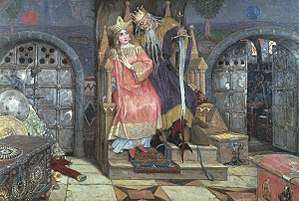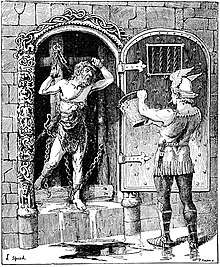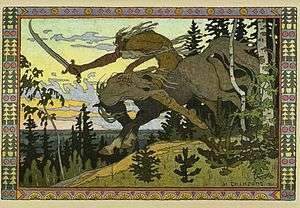Koschei
Koschei (Russian: Коще́й, tr. Koshchey, IPA: [kɐˈɕːej]), often given the epithet "the Immortal", or "the Deathless" (Russian: Коще́й Бессме́ртный), is an archetypal male antagonist in Russian folklore.

The most common feature of tales involving Koschei is a spell which prevents him from being killed. He hides his soul inside nested objects to protect it. For example, the soul may be hidden in the needle that is hidden inside the egg which is carried by the duck that flies away whenever anyone tries to catch it. Usually he takes the role of a malevolent rival father figure, who competes for (or entraps) a male hero's love interest.
The origin of the tales is unknown. The archetype may contain elements derived from the 12th-century pagan Cuman-Kipchak (Polovtsian) leader Khan Konchak, who is recorded in The Tale of Igor's Campaign; over time a balanced view of the non-Christian Cuman khan may have been distorted or caricatured by Christian Slavic writers.
Historicity and folk origins
By at least the 18th century, and likely earlier, Koschei's legend had been appearing in Slavic tales.[1] For a long period no connection was made with any historical character.[2]
Origin in Khan Konchak
The origin of the tale may be related to the Polovtsian (Cuman) leader Khan Konchak, who dates from the 12th century.[n 1] In The Tale of Igor's Campaign Konchak is referred to as a koshey (slave).[n 2][3] Konchak is thought to have come/returned from Georgia (the Caucasus) to the steppe c.1126–1130; by c.1172 he is described in Russian chronicles as a leader of the Polovtsi, and as taking part in an uprising. There is not enough information to reconstruct further details of Konchak's appearance or nature from historical sources; though unusual features or abnormalities were usually recorded (often as epithets) by chroniclers, none are recorded for Konchuk.[4]
The legendary miserliness (love of gold) of Koschei is speculated to be a distorted record of Konchak's role as the keeper of the Kosh's resources.[5]
Koschei's epithet "the immortal" may be a reference to Konchak's longevity. He is last recorded in Russian chronicles during the 1203 capture of Kiev, if the record is correct this gives Konchak an unusually long life – possibly over 100 years – for the time this would have been over six generations.[6]
Koschei's life-protecting spell may be derived from traditional Turkic amulets, not only were these oval (egg) shaped, but they would often contain arrowheads (cf. the needle in Koschei's egg).[7]
It is thought that many of the negative aspects of Koschei's character are distortions of a more nuanced relationship of Khan Konchak with the Christian Slavs, such as his rescuing of Prince Igor from captivity, or the marriage between Igor's son and Konchak's daughter. Konchak, as a pagan, could have been demonised over time as a stereotypical villain.[8]
Naming and etymology
Numerous variant names and spellings have been given to Koschei – these include Kashchei, Koshchai, Kashshei, Kovshei, Kosh, Kashch, Kashel, Kostei, Kostsei, Kashshui, Kozel, Koz'olok, Korachun, Korchun bessmertnyi, Kot bezsmertnyi, Kot Bezmertnyi, Kostii bezdushnyi; in bylinas he also appears as Koshcheiushko, Koshcheg, Koshcherishcho, Koshchui, Koshel.[9] Kachtcheï is the standard French transliteration.
The term Koshey appears in Slavic chronicles as early as the 12th century to refer to an officer or official during a military campaign. The term may have probably originated from the Kushan empire, an Indian and partially Greek kingdom of Central Asia who ruled over much of the area, in a time period preceding the start of this myth. The Kushans were Hellenized Bactrians whose cultural contacts extended into eastern India. They were followers of Buddhism and played an important role in Silk Road transmission of Buddhist culture to the rest of Asia. They may have been seen as a competitor to Christianity when the Kushans empire had already faded away after 600 years. Similar terms include the Ukrainian Кошовий (Koshovoy) for the head of the 'Kosh' (military)[10] as in Kosh otaman. In Old Russian 'Kosh' means a camp, while in Belarussian a similar term means 'to camp' and in Turkic languages a similar term means 'a wanderer'.[11] The use as a personal name is recorded as early as the 15th century on Novogrodian birch bark manuscripts.[12]
In The Tale of Igor's Campaign a similar sounding term is used, recorded being inscribed on coins, deriving from the Turkic for 'captive' or 'slave'. The same term also appears in the Ipatiev Chronicle, meaning 'captive'.[13] A second mention of the term is made in The Tale of Igor's Campaign when Igor is captured by the Polovtsi; this event is recorded as a riddle: "And here Prince Igor exchanged his golden saddle of a prince for the saddle of a Koshey (slave)."[14]
Nikolai Novikov also suggested the etymological origin of koshchii meaning "youth" or "boy" or "captive", "slave", or "servant". The interpretation of "captive" is interesting because Koschei appears initially as a captive in some tales.[12]
In folk tales
Koschei is a common antihero in east-Slavic folk tales. Often tales involving him are of the type AT 302 'The Giant Without A Heart' (see Aarne–Thompson classification systems); and he also appears in tales resembling type AT 313 'The Magic Flight'.[15]
He usually functions as the antagonist or rival to a hero.[16] Love rivalry and related themes are common.[17]
The typical feature of tales concerning Koschei is his protection against being killed (AT 302) – to do so he has hidden his soul inside an egg, and further nested the egg inside various animals, and then in protective containers and places.[18]
In other tales, Koschei can cast a sleep spell that can be broken by playing an enchanted gusli. Depending on the tale he has different characteristics: he may ride a three- or seven-legged horse; may have tusks or fangs; and may possess a variety of different magic objects (like cloaks and rings) that a hero is sent to obtain; or he may have other magic powers.[19] In one tale he has eyelids so heavy he requires servants to lift them[19] (cf. the Celtic Balor or Ysbaddaden, or Serbian Vy).
Psychologically, Koschei can represent an initially benevolent, but later malevolent, father (to a bride) figure.[20] The parallel female figure, Baba Yaga, as a rule does not appear in the same tale with Koschei, though exceptions exists where both appear together as a married couple, or as siblings.[15]

Marya Morevna
Also known as "The Death of Koschei the Deathless", Ivan Tsarevitch encounters Koschei chained in his wife's (Marya Morevna's) dungeon. He releases and revives Koschei, but Koschei abducts Marya. Ivan goes to rescue Marya several times, but Koschei's swift horse allows him to easily catch up with the escaping lovers; each time the magical horse informs Koschei that he will be able to carry out several activities first and still be able to catch up. After the third unsuccessful escape, Koschei cuts up Ivan and throws his parts into the sea in a barrel. Ivan is revived with the aid of the water of life. He seeks Baba Yaga for a suitably swift horse. After trials he steals a horse and rescues Marya.[21]
Tsarevich Petr and The Wizard
Tsar Bel-Belianin's wife the Tzaritza is abducted by Koschei (the Wizard). The Tsar's three sons attempt to rescue her. The first two fail to reach the wizard's palace, but the third, Petr, succeeds. He reaches the Tzaritza, conceals himself, and learns how the wizard hides his life. Initially he lies, but the third time he reveals it is in an egg, in a duck, in a hare, that nests in a hollow log, that floats in pond, found in a forest on the island of Bouyan. Petr seeks the egg, freeing animals along the way - on coming to Bouyan the freed animals help him catch the wizard's creatures and obtain the egg. He returns to the wizard's domain and kills him by squeezing the egg - every action on the egg is mirrored on the wizard's body.[22]
The Snake Princess
In 'The Snake Princess' (Russian Царевна-змея), Koschei turns a princess who does not want to marry him into a snake.
Ivan Sosnovich
The Koschei hears of three beauties in a kingdom. He kills two and wounds a third, puts the kingdom to sleep (petrifies), and abducts the princesses. Ivan Sosnovich (Russian Иван Соснович) learns of Koschei's weakness: an egg in a box hidden under a mountain, so he digs up the whole mountain, finds the egg box and smashes it, and rescues the princess.
He also appears as a miser in Pushkin's Ruslan and Ludmila, though this interpretation does not reflect previous folk tale representations.[12]
Related folklore figures
The Serbian Baš Čelik (Head of Steel); Hungarian 'Lead-Headed Monk'; and Slovak 'Iron Monk' also all hide their weakness inside a series of nested animals.[12]
In popular culture
Film
- Kashchey the Immortal, Russian Кащей Бессмертный, 1945 B&W fantasy directed by Alexander Rou, with Georgy Millyar as Koschei.
- Fire, Water, and Brass Pipes, Russian Огонь, вода и… медные трубы, Ogon, 1968 fantasy directed by Alexander Rou, with Georgy Millyar as Koschei.
- Beloved Beauty, Russian Краса́ ненагля́дная, 1958 stop-animated film.
- Sitting on the golden porch (На златом крыльце сидели), 1986 fairy tale directed by Boris Rytsarev
Opera and ballet
- The villain in Igor Stravinsky's ballet The Firebird.
- Nikolai Rimsky-Korsakov wrote an opera involving Koschei, titled Кащей бессмертный, or Kashchey the Deathless.
Derivative works

- Film
- The Book of Masters, Russian Книга Мастеров, 2009 fantasy
- Lilac Ball, Russian Лиловый шар, 1987 science fiction
- After the Rain, on Thursday, Russian После дождичка в четверг, 1985 musical children's fantasy
- Along Unknown Paths, Russian Там, на неведомых дорожках, 1982 children's fantasy
- New Year Adventures of Masha and Vitya, Russian Новогодние приключения Маши и Вити, 1975 children's film
- Television
- In Little Einsteins, Koschei is a nesting doll named Katschai tried to steal the music power from the magical Firebird. Katschai used animal nesting dolls to try and stop the Little Einsteins team from getting to the Firebird which Katschai had locked up at the top of a building in Russia.
- Novels and comics
- In James Branch Cabell's Jurgen, A Comedy of Justice, and in Robert A Heinlein's retelling of the story Job: a Comedy of Justice, Koshchei the Deathless appears as the most supreme being who made things as they are and is therefore universally unappreciated before Jurgen's kind words are spoken.
- In Alexander Veltman's Koshchei bessmertny: Bylina starogo vremeni (Koshchei the Immortal: A Bylina of Old Times, 1833), a parody of historical adventure novels, the hero, Iva Olelkovich, imagines that his bride has been captured by Koschei.
- Mercedes Lackey's novel of Stravinsky's Firebird features Katschei as the main villain, retelling the classic tale for a modern audience.
- Catherynne Valente's novel Deathless is a retelling of the Koschei story set against a backdrop of 20th-century Russian history.[23]
- In the 1965 science-fiction Monday Begins on Saturday by Arkady and Boris Strugatsky, he is one of the creatures held in the NIIChaVo institute.
- Koschei appears as a character in John C. Wright's "War of the Dreaming" novels. He offers to save the hero's wife, if the hero will agree to take the life of a stranger.
- Koschei appears as a slave to Baba Yaga in the Hellboy comic book series, first appearing in Hellboy: Darkness Calls. Koschei's origin story is later revealed in backup stories to single issues of Hellboy: The Wild Hunt. The story is also collected in Hellboy: Weird Tales and expanded upon in Koshchei the Deathless.
- Koschei also appears in DC Comics The Sandman: Fables and Reflections.
- In the Webcomic PS238 by Aaron Williams, the child hero 84 is currently trapped in Koschei's egg, trying to find the "eye", and in doing so, will become his new Champion of Earth to battle from now on.
- Koschei is the primary antagonist in Marina Frants' short fiction piece "Death Becomes Him", the sequel to "A Bone to Pick".
- Koschei (spelled "Kostej") is an important element in the novel "The Devil Aspect" by Craig Russell; he is the catalyst for one of the novel's mass murderer's actions.
- Koschei serve as antagonist in Second part of Katherine Arden's Winternight Trilogy - The Girl in Tower
- Games
- In the tabletop RPG Pathfinder, he is the inspiration for the Demon Lord Kostchtchie.
- Koschei appears as a character in the MMORPG RuneScape, under the name "Koschei the Deathless".
- In the video game series The Incredible Adventures of Van Helsing, the Death of Koschei is a key plot item in the second game. In the third game, recurring supporting character Prisoner Seven is revealed to be Koschei the Deathless, and becomes the main antagonist.
- In the videogame Shadowrun: Hong Kong, the supporting character Racter has a drone named 'Koschei', which later in the game can gain an upgrade named "Deathless" that makes the drone unkillable.
- In the computer game Dominions 4: Thrones of Ascension, Koschei appears as a hero character for Bogarus, a faction inspired by medieval Russia and Slavic mythology.
- The legend of Koschei the Deathless serves as an inspiration for the narrative of Rise of the Tomb Raider. [24]
- In the digital card game Mythgard, "Koschei, the Deathless" appears as a mythic minion in the Dreni faction.
- In the videogame Arknights, the duke of Ursus (a fictional country based on Russia) is named Koschei, and is hinted to posess the main antagonist after being killed by them.
Notes
- Konchak is an important antagonist in the Tale of Igor's Campaign
- In Leonard A. Magnus's translation : "Shoot, my liege, the heathen Konctik the slave"
References
- KazakhTV 2018, 2. Entertaining etymology. 5:10-.
- KazakhTV 2018, 1. A dossier of the fairy villain. 2:05-2:20.
- KazakhTV 2018, 2. Entertaining etymology. 7:40-8:00.
- KazakhTV 2018, 3. Konchuk's personal file 7:58-11:00.
- KazakhTV 2018, 3. Konchuk's personal file 11:00-12:30.
- KazakhTV 2018, 3. Konchuk's personal file 12:20-13:15.
- KazakhTV 2018, 3. Konchuk's personal file 13:10-13:40.
- KazakhTV 2018, 4. Say a word about the poor Koshey 13:40-15:02.
- Johns 2004, Note 1, p.230.
- KazakhTV 2018, 2. Entertaining etymology. 5:10-5:50.
- KazakhTV 2018, 2. Entertaining etymology. 5:50-6:10.
- Johns 2004, p. 233.
- KazakhTV 2018, 2. Entertaining etymology. 6:05-6:58.
- KazakhTV 2018, 2. Entertaining etymology. 6:50-7:20.
- Johns 2004, p. 230.
- Johns 2004, pp. 231-2.
- Johns 2004, p. 232.
- Johns 2004, pp. 230-1.
- Johns 2004, p. 231.
- Johns 2004, p. 141.
- Lang, Andrew, ed. (1890), "The Death of Koschei the Deathless", The Red Fairy Book
- Wheeler, Post, ed. (1917), "Tzarevich Petr and the Wizard", Russian wonder tales, pp. 309-
- Heller, Jason (7 Apr 2011). "Catherynne M. Valente: Deathless". www.avclub.com.
- August 4, 2015, Alexa Ray Corrie. "Rise of the Tomb Raider's Myths Explained". GameSpot. Retrieved May 4, 2020.
Sources
- "Turkic roots of Koshey The Immortal", Reflections on History (documentary), Kazakh TV (5), 4 Apr 2018
- Johns, Andreas (2004), Baba Yaga: The Ambiguous Mother and Witch of the Russian Folktale, Peter Lang
External links
